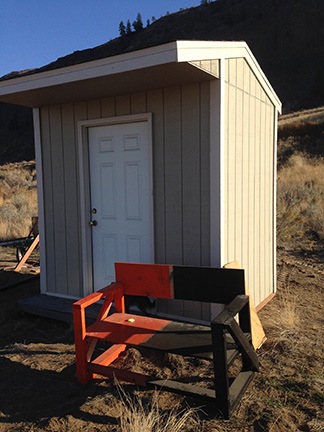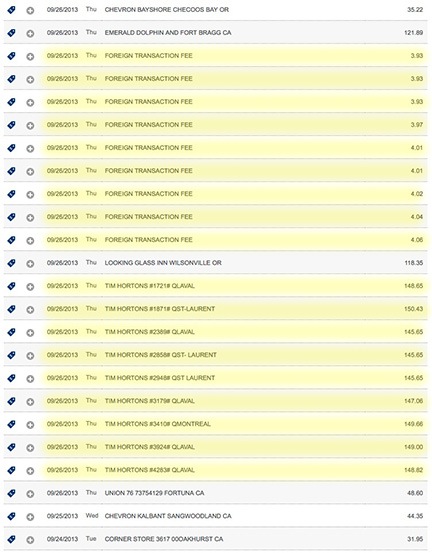I obtain a shed.
As some folks know, I’m renting a hangar at Wenatchee Airport for winter storage of my helicopter, cargo trailer, car, and the furniture and other possessions I took away from my old life in Arizona. The hangar is huge — I’m only using half of its floorspace and even the half I’m using has plenty of room for other things. In fact, my original plan was to store my RV in there for the winter while I migrated to a warmer climate for a few months. I could get everything I own under that one roof and still have room to spare.
For various reasons, however, I decided to stick around in Wenatchee. I got a lot of encouragement from my friends to spend the winter here and join them in outdoor sports such as cross-country skiing, snowshoeing, and snowmobiling. I also have some personal business in state that requires me to be available for meetings. And I’ve even managed to keep flying, with two regular clients keeping me busy once or twice a week. Winters here are about the same as winters back in the New York metro area where I grew up. It had been a long time since I’d experienced a real winter.
Of course, to stick around meant to winterize my RV — a topic I hope to cover in another blog post. Part of winterizing my RV meant clearing items out of the “basement” storage space so I could put a heater in there. I’d also accumulated quite a few tools for property maintenance — weed whacker, rake, shovel, tarps, etc. All of these things had to be stored — most likely in that cavernous hangar 30-40 minutes away by car.
While a storage shed would be nice — and I’d actually been looking at my options on and off for the past few months — the idea of building one this time of year did not appeal to me. And the cost of buying a small one was simply not justifiable considering I’d have a big storage building of my own onsite within 6 months. So I’d pretty much resigned myself to storing in the hangar and simply not having the stored things around.
The Little Shed
That was the idea until I saw a fully-built 6 x 8 foot shed with metal door and window sitting on a trailer on the side of the road with a For Sale sign on it.
I drove by but immediately stopped and made a U-turn. I parked beside it and read the sign. $600.
That couldn’t be right. It looked brand new.
I called the phone number. The man who answered confirmed that it was still available and priced at $600.
“Would you deliver it?” I asked. I went on quickly: “I live on Cathedral Rock Road. It’s about 15 minutes from where the shed is parked now.”
“I’d have to charge extra for delivery.”
“How much?”
“A couple of hundred dollars, I guess. I’ll need a crew to help me.”
I could see this little shed slipping away. I had to acquire the shed at a price that made it not just a good deal but a great deal. “I can’t see paying a couple of hundred dollars to deliver a $600 shed,” I told him, slipping into New Yorker make-a-deal mode. “I’ll give you $700 total, including tax and delivery. Cash.”
“Let me think about it,” he said.
I was back home when he called an hour later. “I’ll take that offer,” he said. “Can I bring it by on Monday?”
Later, I looked up similar sheds on the website for the local company that had likely built it. They didn’t list sheds that small; the smallest listed on the site was 8 x 8. That was priced at $2,970.
Taking Delivery
We made arrangements for him to come sometime on Monday. On Monday he called with a two hour window in the middle of the day. He showed up right near the end of that window. Didn’t matter to me; I was working around the yard all day anyway, finishing up work on my new water line.

My new shed arrived on a flatbed trailer.
He arrived with the shed on a trailer and drove it right down my driveway. His companion and I guided him while he backed up into my preferred off-loading area. This was right beside my temporary power pole, not far from my water line. I didn’t want the darn thing blocking my view.
While we waited for the rest of his crew to come with a forklift, I asked him about the shed. What was the story? It looked like I was getting a good deal.
“You’re getting a great deal,” he told me. Apparently, the shed had been bought by a local school for some sort of project. It sat on the school grounds for a while. Then the school called him and asked him to take it away. His business, after all, was delivery. Although he didn’t say, I suspected that the school had given him the shed for free in exchange for the removal service. The only cost he likely had in it was the labor of moving it. That would explain why it was so cheap.
Then he told me that he owned a vacation house at Lake Chelan and was going to put the shed there if he didn’t sell it. I told him that it was just what I needed for the winter and that it fell within my very limited budget for a shed. I told him that although I don’t usually believe that things happen for a reason, finding this shed at this price was changing my beliefs.

They used a forklift to move the shed off the trailer. They estimated that it weighs about 3,000 pounds.
As we talked, a long flatbed came down the road, pulled by a tractor truck. They rolled past my place and turned around farther down the road where it gets wider. A while later, the 3-wheeled forklift that had been on the trailer came chugging down my driveway with one man behind the wheel and another standing on a fork. Soon they were using the tie-downs they’d brought along to fasten the shed to the forklift and lift it off the trailer. Then it was on the ground.
They positioned it on an angle I didn’t like. I asked the forklift driver if he could straighten it somehow. The team put a wooden chock beside the skid on the front and the forklift operator used one of the forks to shift the front end over a foot and a half. It was lined up perfectly.
I put a level on the little porch. It was even relatively level.
I paid the boss with money from my rainy day cash fund and he handed over the keys to the locks. Then they all left.
Enough Space…and a Bonus

Inside the shed was a silly little bench.
Inside, I found an odd homemade bench that was likely painted in the school colors. I dragged it out. Although it needs a little work to be usable, I think it would be perfect for what I’ve begun calling “lookout point” — a part of my land that sits in the northwest corner, with completely unobstructed views of the Wenatchee Valley and Columbia River before my land drops off steeply to the valley below. I’ll move it over there the next time a friend drops in and paint it the next time the weather forecast includes several consecutive clear days. Or, more likely, I’ll just leave it where it is with a tarp over it and wait until spring to fix it up and put it in place, probably with a nice cushion. (I’m pretty sure I took the cushions that were on the teak recliners back in Wickenburg. Side-by-side, they’d be perfect.)
I spent the rest of the afternoon stowing my yard tools and basement items neatly inside the shed. It’s a shame the door was mounted opening in; that really cuts down on usable space. But I have some shelves from Ikea (also taken from my Wickenburg home) that I can assemble in there to increase the amount of storage space. And a few hooks on the walls would likely make it even more usable. The man I bought it from suggested a loft — the ceiling is 10 feet at the peak — but I don’t think it’s worth the effort. We’ll see.
Overall, it was exactly what I needed for convenient, cost-effective storage of pesky basement and yard items. It’s great to get all of that stuff out of the elements without having to take them to my hangar.







